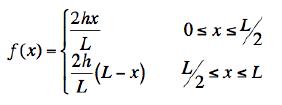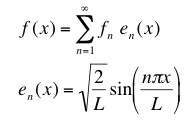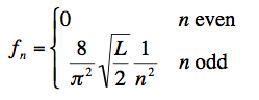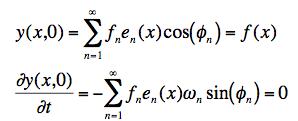
Problems for
Intermediate Methods in Theoretical Physics
Edward F. Redish
 |
Problems for Edward F. Redish |

could be expanded in a Fourier series

with Fourier coefficients:

(a) If at time t = 0 the string is plucked in the center so that when it is released:

then find an expression that will give the shape of the string for all times, y(x, t).
(b) Assuming that it is OK to ignore any damping or internal friction, will the string ever resume its original shape after it has been released? If so, will it do it regularly? If so, with what period? Explain carefully how you came to your conclusion.
(c) Suppose that instead of plucking the string in the center, you plucked it 1/4 of the way from one end to the other. Answer the same question as in (b).
Solution
(a) We know that the time dependence of each normal mode, en(x), is that it oscillates with the frequency ωn. By this, we mean that the time dependent solution for the normal mode is:
![]()
(where we use the cos with a phase rather than separate sin and cos terms for ease of handling -- though both ways work). This means our general solution as a function of time will be:

We determine the phase Φn by fitting the initial conditions:

To match the initial conditions, we have to take all the Φn = 0 . This gives the result for the time dependence
 .
.
(b) The string will return to its original shape if all of the cos terms ever get back to 1. The first term becomes 1 when ω1t becomes 2π times any integer. At any time that ω1t = a positive integer times 2π then ωnt = nω1t also equals a positive integer times 2π. So the shape will repeat with the period of the first mode, 2π/ω1.
(c) Trick question. As long as the series contains a first term, when it repeats doesn't depend on the coefficients. It will repeat with the same period. If the string is started in a shape that prevents the odd terms from contributing (i.e., all the fn = 0 for odd n), then the period would be the period of the first even term -- half the period found in (b).
| University of Maryland | Physics Department | Physics 374 Home |
|---|---|---|
 |
 |
 |
Last revision 29. November, 2005.